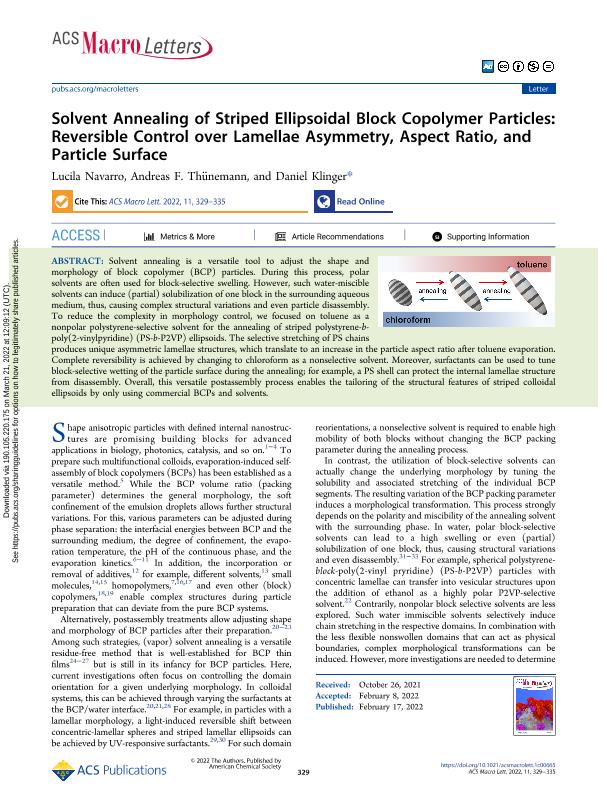Artículo
Solvent Annealing of Striped Ellipsoidal Block Copolymer Particles: Reversible Control over Lamellae Asymmetry, Aspect Ratio, and Particle Surface
Fecha de publicación:
03/2022
Editorial:
American Chemical Society Inc
Revista:
ACS Macro Letters
ISSN:
2161-1653
Idioma:
Inglés
Tipo de recurso:
Artículo publicado
Clasificación temática:
Resumen
Solvent annealing is a versatile tool to adjust the shape and morphology of block copolymer (BCP) particles. During this process, polar solvents are often used for block-selective swelling. However, such water-miscible solvents can induce (partial) solubilization of one block in the surrounding aqueous medium, thus, causing complex structural variations and even particle disassembly. To reduce the complexity in morphology control, we focused on toluene as a nonpolar polystyrene-selective solvent for the annealing of striped polystyrene-b-poly(2-vinylpyridine) (PS-b-P2VP) ellipsoids. The selective stretching of PS chains produces unique asymmetric lamellae structures, which translate to an increase in the particle aspect ratio after toluene evaporation. Complete reversibility is achieved by changing to chloroform as a nonselective solvent. Moreover, surfactants can be used to tune block-selective wetting of the particle surface during the annealing; for example, a PS shell can protect the internal lamellae structure from disassembly. Overall, this versatile postassembly process enables the tailoring of the structural features of striped colloidal ellipsoids by only using commercial BCPs and solvents.
Palabras clave:
BCP
,
ELIPSOIDAL PARTICLES
,
SOLVENT SWELLING
Archivos asociados
Licencia
Identificadores
Colecciones
Articulos(INTEC)
Articulos de INST.DE DES.TECNOL.PARA LA IND.QUIMICA (I)
Articulos de INST.DE DES.TECNOL.PARA LA IND.QUIMICA (I)
Citación
Navarro, Lucila; Thünemann, Andreas F.; Klinger, Daniel; Solvent Annealing of Striped Ellipsoidal Block Copolymer Particles: Reversible Control over Lamellae Asymmetry, Aspect Ratio, and Particle Surface; American Chemical Society Inc; ACS Macro Letters; 11; 3; 3-2022; 329-335
Compartir
Altmétricas




